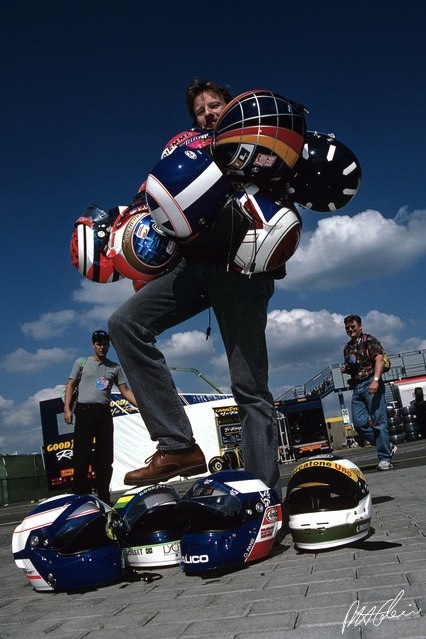
How many helmets can one person carry? German GP 1996
(Photo Paul-Henri Cahier)
Working with Arai happened by degree. The introduction came through Satoru Nakajima in 1988. I spent time with the guys at the factory in Ohmiya, just north of Tokyo, and learned the basics about helmet construction and maintenance.
The characters at Arai are amazing people from Mitch Arai at the top throughout all the staff I worked with over the years. The key principles of safety were what they worked incredibly hard to do to the highest standards. Unlike some safety companies, profit was never the most important aspect for Arai.
In fact I seem to remember Mitch Arai telling me that on car racing helmets he never expected to make any money at all – if he could just cover the cost, that in itself, would be an achievement. What he wanted to achieve was to contribute to the safety in car racing from everything they had learned from motorbike racing. In bike racing they were the absolute ultimate helmet to have.
Hiro Kimura was my main contact in Japan being the liaison for teams and drivers. Tadahiro Takahashi was the main contact on the technical side. So, while at Team Lotus I had to negotiate supplies of helmets and parts with Hiro and worked closely with Taka on technical aspects. Both have remained friends through all the years since then.
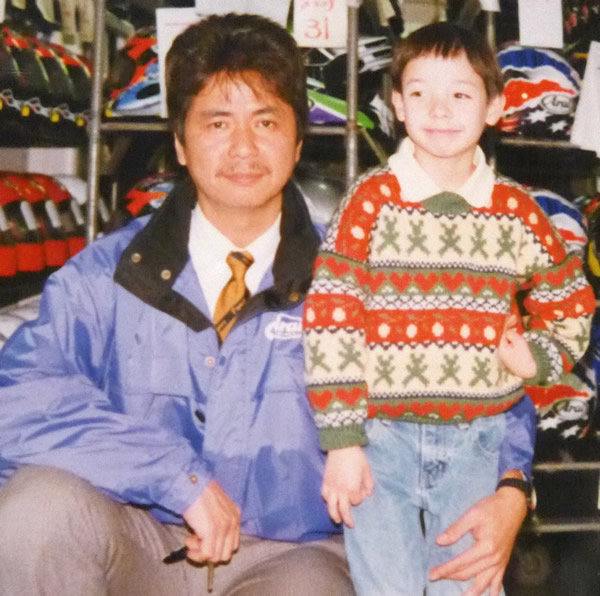
Hiro Kimura of Arai Helmet Ltd with my son Sean at Arai (late 1990’s)
(Photo James Penrose)
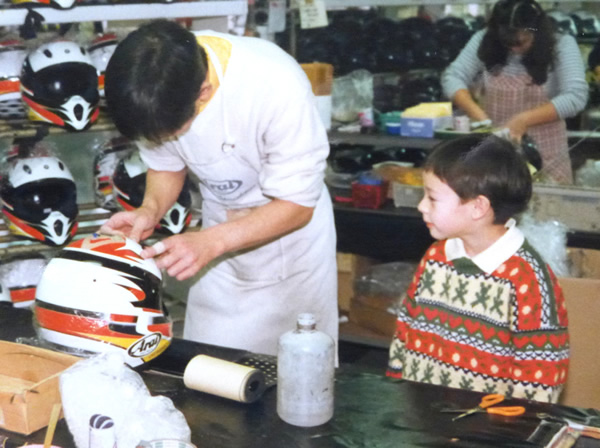
Arai production line (late 1990’s): Sean
(Photo James Penrose)
When my time at Team Lotus came to a close in 1993 I went through nearly two years out of F1. It wasn’t at all bad, but it wasn’t really what I wanted to be doing so towards the end of 1994 I took some holiday in order to go to the final GPs of that year in Japan and Australia, the intention being to find a job back in F1. I’d managed to get a guest pass for each race and called Hiro to see if he could recommend a cheap hotel near Suzuka circuit.
As it happened Arai had very recently parted with their UK importer who helped with the F1 racing service at that time. So they were in limbo, it was their home Grand Prix and because they had ‘outsourced’ the F1 service they didn’t know the F1 scene or F1 people very well. Hiro asked if I could help and introduce their local racing service staff to the F1 teams and drivers.
This was 1994 I was married to Yumi, originally from Tokyo, so the people at Arai accepted me as a Japanesised Geijin (foreigner). They hadn’t let anyone into their circle from outside before. So I arrived in Japan, stayed with Yumi’s family for a few days and then went from the Arai factory by road with the Arai staff to Suzuka.
At Suzuka I introduced the Arai Racing Service people to the F1 teams and drivers and watched how they worked. During the race weekend they asked me if I could look after their drivers in Australia at the next GP, a bit surprised I agreed and so I spent the rest of the weekend learning the ropes fully.
We drove back to Tokyo after the Grand Prix and I spent the week between the 2 races at Arai learning a lot more about helmets – Tadahiro Takahashi was a good teacher. It was a time of new experiences – staying with Yumi’s family and travelling out to Ohmiya on the train early every morning. Arriving there and the entire staff starting the day with fitness exercises outside – very different from work in Europe.
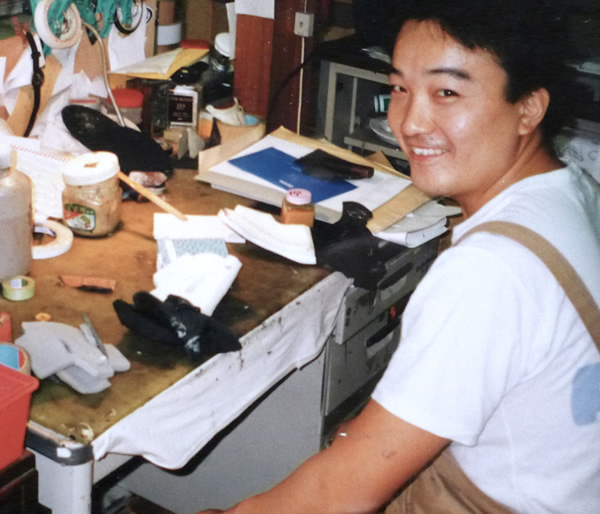
Tadahiro Takahashi of Arai Helmet Ltd.
(Photo James Penrose)
During those days I learned why fitness was important, the days were long and physically hard – putting liners in helmet shells is seriously strenuous. This learning proved essential in the coming years.
In Australia I stayed with an old friend, Bob Brinkworth, who had supplied Team Lotus with Honda generators for many years for the GP in Adelaide. I worked the GP, stayed on for some days and ended up going Opal mining in Minterbie about 18 hours north of Adelaide, but that tale is for another time.
On the way back I went via Japan, Yumi and our son Sean had stayed there during my trip to Australia GP. Time back in Ohmiya at the Arai factory and more training as Arai had decided to ask me to handle their F1 racing service through 1995.
1995 F1 season started in Brazil at Interlagos in Sao Paulo. I had no pass to get into the track – in those days helmet companies were expected to get a pass from one of their contracted drivers. Each driver had 2 guest passes and with the majority being contracted to Arai there was some hope – but if a driver had a manager and girlfriend or wife or sponsor with them….. no spare pass.
At Interlagos I managed to get into the track with no pass, but was outside the F1 paddock and when I asked the top running Arai driver if I could borrow a pass to get into the paddock / pits area so I could look after his and other Arai contracted drivers helmets for the race weekend I got a flat no.
This race was significant in that the training I’d received from Arai the previous winter was needed right at the start. Remember what I said about the physically hard job fitting liners into helmet shells? It is a hard job doing it in the factory, but imagine doing it in a public area at a racetrack or a hotel room.
Day 1: Rubens Barrichello arrived with two specially painted helmets. This being the first Brasilian GP since the death of Ayrton Senna, Rubens had asked Sid Mosca, the famous Sao Paulo helmet painter, to make a special commemorative design.
In painting them Sid had done what many painters (incorrectly) do and removed the insides of the helmets to make it easier to paint. The liners were totally loose in the shells and I had to get 2 new liners, make them from standard to made-to-measure, at the track, and refit into the shells overnight before first practice.
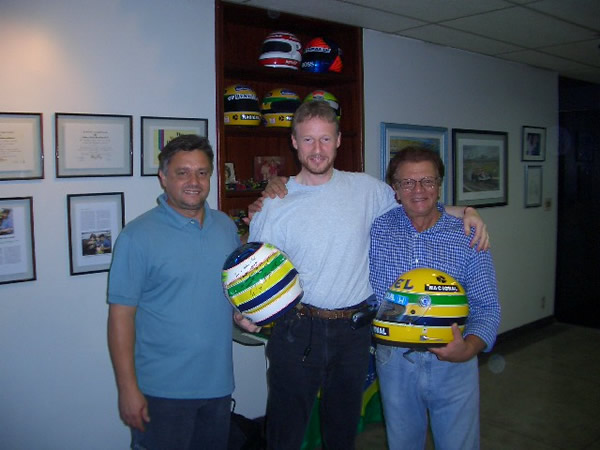
Sid Mosca, James Penrose, Alan Mosca with one of the two 1995 Brasil GP Rubens Barrichello helmets and one of Ayrton’s helmets.
(Photo Mariana Christofolleti)
At that race there were, I think, 18 or 19 of the total of 26 drivers using Arai helmets. That meant preparing 2 or 3 helmets per driver, clear, medium, dark and rain visors (clear / yellow) for each driver for each helmet for each practice. Normally 1 tear-off for practice. Add fitting radio kits and drink kits into the helmets if the drivers wanted them ‘factory-fitted’ rather than mechanic fitted.
This is the amount of work – before / after each practice session, plus cleaning helmets, aero modifications, repairs etc.. The same number of visors per driver for the race, but with 2 or 3 or 4 tear-offs per visor for the race. Do the sums and you’ll realize just how much preparation was necessary.
So, for the first day I was sitting outside the paddock in the public area – preparing helmets and visors in the open, nowhere to work. Basically preparing and passing them over the fence to the drivers! All because of no entry pass. Helmet servicing was not considered important enough to justify a pass.
Extraordinary situation to be in. F1 can seem to be so professional and well run in many ways but can be unbelievably petty in so many ways. On Day 2: I was talking to Johnny Herbert (Benetton) through the fence and Michael Schumacher came up, understood the situation and loaned me a pass for the weekend – Michael was the No 1 Bell driver.
A short way into the season David Coulthard started having problems, essentially he’d been Williams test driver in 1994 and was suddenly promoted to race driver after Ayrton’s death. David alternated with Nigel Mansell for races where Nigel was committed to racing in USA.
David had standard helmets (not made-to-measure) and they’d been made using a liner of a shape that suited him prior to F1 but something changed in his preferences once in F1 and they no longer fitted well.
To explain – helmet liners are made according to the most common shaped head in the geographical region – essentially there are 3 head shapes – round (Asian), oval (European) and American (long front to back and very narrow side to side).
While not all people in those geographical regions are the same these are the predominating head shapes and so liners for helmets sold in those regions follow that. It is something F1 mechanics wanting to pick up a top Arai motorbike helmet cheap in Japan often realize after they’ve bought it – the inner shape isn’t the shape of their head if they buy a Japan market helmet!
After the Brazil & Argentina GPs we had a couple of weeks gap to the next GP and I had a chance to do new measurements for DC and remake his helmets. Again the training was essential to achieving this. Once the old helmets had been modified I made a totally new helmet to exactly the new spec and it went off to Arai’s favoured helmet painter Mike Fairholme.
I’d known Mike for years from sending helmets to him to paint from Team Lotus and it has always been a pleasure to work with him. This helmet was different in that it incorporated two different things from DC’s standard helmet – firstly the ‘ears’ – aero parts on the sides which significantly improved the aero balance. Secondly the 6 slots in the chinbar to give a clean airflow and stop fogging.
Helmets in those days did not have the double screen visors we have now and only had a thin anti-fog film on the inside of the helmet – it worked so long as the chinbar vents were a) there, b) kept clear.
However there were a couple of things that got in the way of this, a) team marketing departments who wanted to sell a ‘clean’ chinbar area to a sponsor and didn’t want ventilation slots and b) the radio fitters who didn’t want airflow over the microphone upsetting the sound coming through in a nice way.
Ken Rumbold of MRTC and I have been ‘sparring partners’ a while on this subject – Ken putting helicopter tape on the inside of the chinbar vents to block them and make his radio kits work well and me removing the heli-tape to resolve fogging complaints of the drivers!
Really it was a no-win situation either way – no way the driver could see where he was going without ventilation and it was important the team could hear what he was saying as well. So Ken and I went back and forth for another year and a half before I had a solution to resolve it for both of us. More of that later.
So the season went on, we got to Japan, I was asked to continue with Arai for the next year and after Australia it was winter testing time.
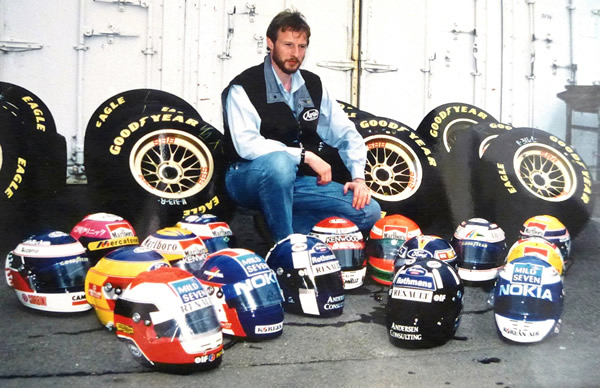
Japan GP 1995 – a tired James Penrose, end of season.
(Photo Jad Sharif, Pan Images)
In 1996 I worked on a good deal of development. We were working on aerodynamic improvements to get a better airflow over the helmet, stability and help the air into the engine airbox get there better.
For 1996 I’d managed to negotiate that helmet racing service staff could have a ‘green’ pass (paddock only but not pits) – so we no longer had to borrow passes off drivers or pass serviced helmets over fences. That was fine for all races where one could go into the back of the garage to access the teams and drivers.
But at Monaco the pits were separate and a ‘green’ paddock pass did not get one into the pits – hence any problems could not be solved unless the helmet came back to the paddock.
So just before the race in Monaco – after no ‘reported’ issues through the previous days or in the wet warm-up session that morning. But on the warm-up pre-grid lap DC had a fogging issue – couldn’t see where he was going.
It was manner from heaven for the manager at the time who appeared to have been trying to get DC into a Bell contract for a good while. Suddenly DC had a Michael Schumacher Bell – with branding modified – on his head and was on the grid for the race!
It was fait accompli, nothing I could do. I couldn’t get into the pits, the radio had been ripped out of the Arai trashing the cheekpads and slapped into the Bell. I nearly lost my job when it was seen that DC was using a Bell on TV. Once the pass situation was explained, the calm returned. And DC returned to using Arai for the rest of his career.
I still have Olivier Panis, the race winner’s, Arai helmet from that race – no fogging problems at all and it wasn’t as though he hadn’t been behind other cars in the spray through a good bit of the race, before taking the lead.
Aero development had started with the ‘big ears’ for Nigel Mansell at Indy and small and medium ‘ears’ in F1. The medium ‘ears’ became pretty much standard in 1996. I undertook a prototype testing programme with Johnny Herbert, Mark Blundell, Olivier Panis and Alain Prost.
As the first three drivers were fairly close in size I could modify inside fitting (and outside branding) enough for testing purposes and we learned a lot from a couple of prototype helmets and a few tests. So the designs were close to completion for the new GP-4 for the following season.
But in terms of the immediate situation there was a way to go, and while we were testing these developments a small situation occurred at the British GP. Martin Brundle, teammate to Rubens Barrichello at Jordan had one of the Bell Feuling model helmets.
The Feuling was a helmet designed for Indy – the whole shape round at the front, flat at the back, designed for airflow on a superspeedway in USA.
Arai’s conceptual central design for helmets has long been that a helmet must be close to round – or as close to human head shape as possible and as smooth as possible on the outside so there are no things to catch or prevent a smooth rotation.
If a helmeted head can rotate smoothly in an accident (note this is prior to the invention of the HANS), then it stands the best chance. If something ‘catches’ or prevents the smooth rotation suddenly then there is a problem – the helmeted head stops rotating but the brain inside the skull does not. Result – not so good.
So the designs we were working on were specifically to have aero parts to make the airflow do what we wanted – but this had to be achieved by add-on aero parts that would a) not prevent smooth rotation and b) would crush easily on an impact and so not prevent the helmet protecting in the way required.
F1 teammates often play a ‘wind-up’ on each other. At Team Lotus Mika Häkkinen and Johnny Herbert sometimes shared a hotel room and a favourite Johnny trick would be to stay in the shower as long as possible when there was a sponsor event they both had to go to and at the last minute unscrew the shower head and put an Oxo cube in and let Mika have the shower with almost no time to get ready…… gravy hair!
For several races Martin had been winding up Rubens over the wonderful Bell Feuling helmet that was giving him xxx more horsepower or kph or whatever and at Silverstone the Bell rep turned up with a Feuling painted in Rubens colours.
Rubens was an Arai contracted driver, as such he had to use Arai helmets. I was given the job of telling him that if he used the Bell then he’d no longer be an Arai contracted driver and would have to return all the Arai’s he had for the 1996 season. Rubens exploded, said a lot of stuff at full volume and hurled a helmet down the truck at me.
Not the best experience. I continued to prepare his helmets, but as he wouldn’t speak to me it was a bit by guesswork. Curiously Rubens qualified faster in his Arai than Martin in his Bell at that event; And in the race Rubens pulled into the pits and got out of the car to retire, but:
Back in the truck Gary Anderson did some swift calculations and as so many cars had gone off and crashed or retired – suddenly he realized they were in the hunt for a decent points finish as very few cars were likely to finish. Another dry helmet was prepared fast, Rubens ran out, got back into the car and finished the race 4th.
Sometime during 1996 another thing happened which showed the value of a well fitting helmet. Sauber had Ford engines that year and they were not giving much power. I’d noticed that Heinz-Harald Frentzen had been using standard size helmets. Somehow he’d never asked for made-to-measure.
I measured him, adjusted the fit of his helmets and when he sat down in the car the top of his helmet was 13mm lower than before. That was with very minor adjustments to the interior with correct adjustments to the foam inside the liner only. It made a notable improvement in the air going into the engine airbox. + air = more hp = result! Oh, and the helmet fitted better too.
Through the balance of 1996 things progressed as normal and gradually the new GP-4 design came to be finalized. The first prototypes arrived at the final GP of the year – Suzuka for Damon Hill (Williams) and Alain Prost (McLaren test driver). Damon used his in qualifying for the race that made him the 1996 World Champion.
This helmet achieved several things – on the aero side an rear aero part that did much of what the Bell Feuling did – but it didn’t compromise Arai’s principle of keeping the overall clean shape of the helmet. This aero part has now been replicated across many helmets – Bell, Schuberth, Stilo…..
On the ventilation side a duct on the inside of the helmet venting the air coming into the chinbar slots up onto the inside of the visor, thus helping to prevent fogging but also keeping air off the microphone and allowing effective radios. Ken Rumbold from MRTC was much happier with that and we still chat at races in a good way! This concept has also been taken up by other helmet manufacturers since 1996.
Additionally internal ventilation channels within the liner helped make for more effective cooling and extraction of sweaty air. This also has been taken up by other helmet manufacturers since 1996.
So that was the end of 1996 or was it…. No I stayed on at Suzuka for a private testing session. Bridgestone had hired the track for Damon Hill to test the Ligier / Arrows and so I was on hand along with the local Arai guys to look after helmets.
I worked on more helmets for Hill’ early 1997 Arrows testing, some for Heinz-Harald Frentzen and Mika Salo. But that was the end of my full time work with Arai.
Financial pressure meant I had to find a job earning more to support my family. I’d done some consultancy through 1996 with Bridgestone and they persuaded me to join them for 1997. I was extremely reluctant as I loved the work with Arai and working with such genuine people.
Early in 1997 Peter Bürger came to visit me in London and I did the best I could to teach him what Taka had taught me over the years from 1988 to 1996. Since that time I’ve continued to do jobs from time to time for Arai – last minute made-to-measure or lining refits etc. Every time I get back involved with them is a pleasure. Peter has continued the racing service work taking up where I left off in 1997 and we remain friends to this day.
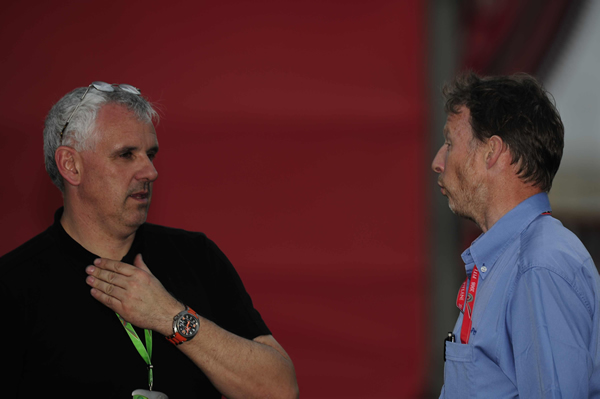
Peter Bürger (Arai), James Penrose (FIA) – we aren’t arguing, really
(Photo Hiroshi Kaneko)
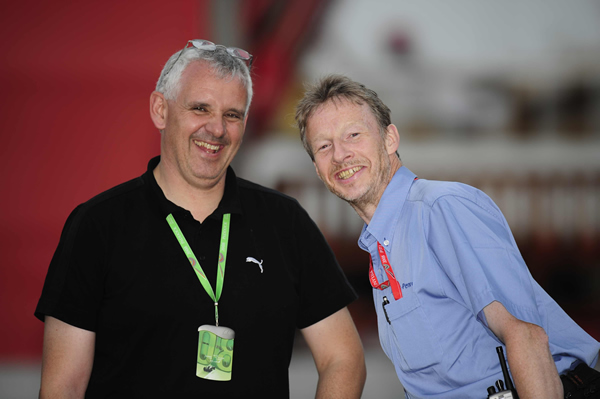
Peter Bürger (Arai), James Penrose (FIA)
(Photo Hiroshi Kaneko)